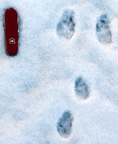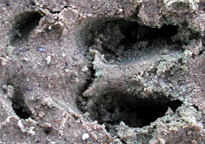Larger, Toes Not Distinct
over 1 inch in some dimension, with toes hard to count
(click on photos to see a larger version)
Eastern Cottontail Rabbit
Eastern Cottontail Rabbit
- size: over 1 inch (back much longer)
- toes hard to count
- claws might not show up
The toes of cottontails are hard to distinguish. You might see claw marks in the footprint, but counting the toes would be nearly impossible. Their front feet are about 1 inch wide and just a little bit longer (1 inch). Their back feet are about 1 inch wide, and significantly longer (3 inches).
Usually you will find that the back feet will be in front of the front feet in their tracks. This is because rabbits cross their back feet in front of the front feet when they hop. The back footprints will almost always be spread wider apart than the front feet.
White-tailed Deer
White-tailed Deer
- size: over 1 inch
- toes hard to count (hooves)
White-tailed deer are probably the only hoofed animal tracks you will see in southern Michigan. Deer tracks are made of two nearly identical crescent shapes placed right next to each other. They usually make a sort of heart shape because they are rounded on the back end and more pointed on the front. Each half of the track looks a bit like a tear-drop.
Their front hooves are about 1.8 inches wide and 3 inches long. Their back hooves are about 1.5 inches wide and 2.6 inches long, making them slightly smaller than the front tracks.
Deer actually have 4 toes on both their front and back feet. If they are running fast through soft mud or snow, you will see the two toes forming a heart shape with two more small toes behind that. An interesting fact about deer tracks is that expert trackers can tell if the deer is a male or a female based on how far apart their hind tracks are.





